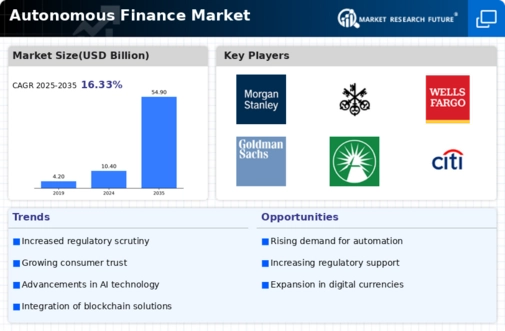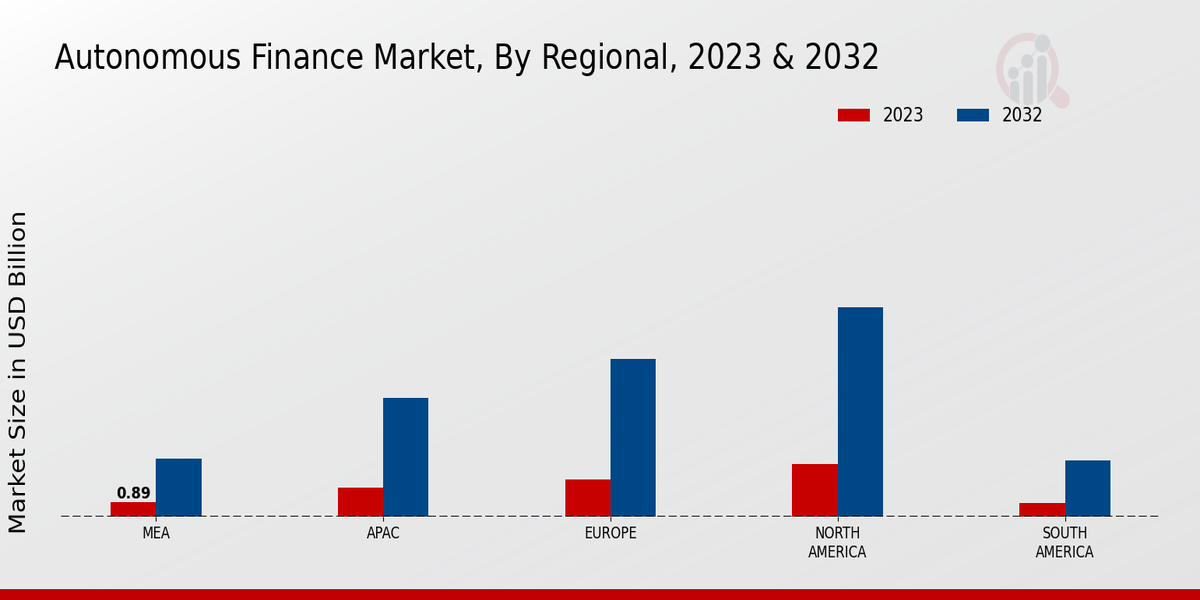Regulatory Support
Regulatory frameworks are evolving to support the Global Autonomous Finance Market Industry, fostering an environment conducive to innovation. Governments worldwide are recognizing the potential of autonomous finance to enhance financial inclusion and stability. For example, regulatory bodies in various countries are implementing guidelines that encourage the adoption of fintech solutions. This supportive regulatory landscape is likely to drive market growth, with projections indicating a rise to 54.9 USD Billion by 2035. The alignment of regulations with technological advancements suggests a collaborative approach that could further accelerate the adoption of autonomous finance solutions.
Market Growth Projections
The Global Autonomous Finance Market Industry is on a trajectory of significant growth, with projections indicating a market size of 10.4 USD Billion in 2024 and an anticipated increase to 54.9 USD Billion by 2035. This growth reflects a compound annual growth rate of 16.34% from 2025 to 2035, highlighting the increasing adoption of autonomous finance solutions across various sectors. The market's expansion is driven by technological advancements, regulatory support, and changing consumer preferences, suggesting a robust future for autonomous finance.
Technological Advancements
The Global Autonomous Finance Market Industry is propelled by rapid technological advancements in artificial intelligence and machine learning. These technologies enhance decision-making processes, enabling financial institutions to automate complex tasks such as risk assessment and portfolio management. For instance, AI-driven algorithms can analyze vast datasets to identify investment opportunities, thereby increasing efficiency and accuracy. As a result, the market is projected to reach 10.4 USD Billion in 2024, reflecting a growing reliance on technology in finance. The integration of these innovations not only streamlines operations but also reduces costs, making financial services more accessible globally.
Data-Driven Decision Making
The Global Autonomous Finance Market Industry is increasingly characterized by data-driven decision-making processes. Financial institutions are harnessing big data analytics to gain insights into consumer behavior and market trends. This capability allows for more informed investment strategies and risk management practices. For example, predictive analytics can forecast market fluctuations, enabling firms to adjust their portfolios proactively. As organizations continue to prioritize data utilization, the market is poised for substantial growth, with projections indicating a rise to 54.9 USD Billion by 2035. The emphasis on data-driven approaches underscores the transformative potential of autonomous finance.
Consumer Preference for Automation
Consumer preferences are shifting towards automation in financial services, driving the Global Autonomous Finance Market Industry. Individuals increasingly seek seamless and efficient financial solutions that require minimal human intervention. This trend is evident in the rising popularity of robo-advisors and automated trading platforms, which offer personalized investment strategies without the need for traditional financial advisors. As consumers become more comfortable with technology, the demand for these automated solutions is expected to grow. This shift in consumer behavior is likely to play a crucial role in shaping the market landscape in the coming years.
Increased Demand for Financial Inclusion
The Global Autonomous Finance Market Industry is significantly influenced by the increasing demand for financial inclusion. Many underserved populations lack access to traditional banking services, creating a substantial opportunity for autonomous finance solutions. By leveraging technology, financial institutions can offer tailored services to these demographics, thereby expanding their customer base. For instance, mobile banking applications and automated credit scoring systems are examples of how technology can bridge the gap. This trend is expected to contribute to a compound annual growth rate of 16.34% from 2025 to 2035, indicating a robust market response to the need for inclusive financial services.
















